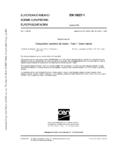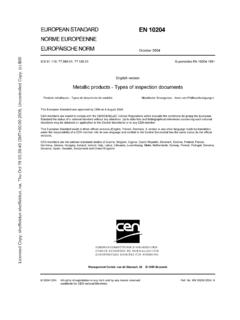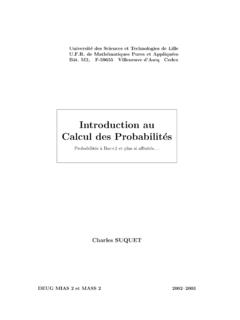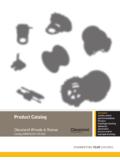Transcription of EUROPEAN STANDARD EN10002-5 - sanyosteel.com
1 EUROPEAN STANDARDNORME EUROP ENNEEUROP ISCHE NORMEN10002-5 October1991 UDC669 : Metal products, mechanical tests, tension tests, high temperature tests, definitions, designation, test specimen, testing conditions, elongation at break, elastic limitEnglish versionMetallic materials Tensile testing Part5: Method of testing at elevated temperatureMat riaux m talliques Essai de traction Partie 5: M thode d essai temp rature lev eMetallische Werkstoffe Zugversuch Teil5: Pr fverfahren bei erh hter TemperaturThis EUROPEAN STANDARD was approved by CEN on9 October1991. CENmembers are bound to comply with the CEN/CENELEC Internal Regulationswhich stipulate the conditions for giving this EUROPEAN STANDARD the status ofa national STANDARD without any lists and bibliographical references concerning such nationalstandards may be obtained on application to the Central Secretariat or to anyCEN EUROPEAN STANDARD exists in three official versions (English, French,German).
2 A version in any other language made by translation under theresponsibility of a CEN member into its own language and notified to theCentral Secretariat has the same status as the official members are the national standards bodies of Austria, Belgium,Denmark, Finland, France, Germany, Greece, Iceland, Ireland, Italy,Luxembourg, Netherlands, Norway, Portugal, Spain, Sweden, Switzerland andUnited Committee for StandardizationComit Europ en de NormalisationEurop isches Komitee f r NormungCentral Secretariat: rue de Stassart36, B-1050 Brussels CEN 1991 Copyright reserved to all CEN membersRef. No. EN10002-5 :1991 EEN10002-5:1991 BSI 04-19992 ForewordThis EUROPEAN STANDARD was prepared by the Technical Committee ECISS/TC1A Mechanical and physical tests , the Secretariat of which has been allocated to the Association Fran ais de Normalisation (AFNOR).
3 It represents the fifth part of the general STANDARD : Metallic materials Tensile EUROPEAN STANDARD replaces the EURONORM:EU2270 Determination or verification of the yield point of steel at elevated EUROPEAN STANDARD EN10002-5 was approved by CEN to the Common CEN/CENELEC Rules, being part of the Internal Regulations of CEN, the following countries are bound to implement this EUROPEAN STANDARD :Austria, Belgium, Denmark, Finland, France, Germany, Greece, Iceland, Italy, Luxembourg, Netherlands, Norway, Portugal, Spain, Sweden, Switzerland and United 2 Introduction 51 Scope52 Normative length (L) length (Lc) gauge reduction of area (Z) force (Fm) and designations76 Test and of test pieces77 Determination of originalcross-sectional area (So)78 Marking the original gauge length (Lo)99 Testing device910 Conditions of of the test of the test of the of gripping1011 Determination of percentageelongation after fracture (A)1012 Determination of proof strength(non-proportional extension (Rp)1113 Determination of proof strength(total extension) (Rt))
4 1114 Method of verification of permanentset strength (Rr)1215 Test report12EN10002-5:1991 BSI 04-19993 PageAnnex A (Normative annex)Types of test piece to be used for thin products: sheets, strips and flats and3mm20 Annex B (Normative annex)Types of test piece to be used in the case of wire, bars and sections with a diameter or thicknessof less than4mm 21 Annex C (Normative annex)Types of test piece to be used in the case of sheets and flats of thickness equal to or greater than3mm,and wire, bars and sections of diameter orthickness equal to or greater than4mm21 Annex D (Normative annex)Types of test piece to be used in the case of tubes 23 Annex E (Normative annex)Measurement of percentage elongation after fracture, basedon sub-division of the original gauge length24 Annex F (Informative annex)
5 List of national standards corresponding to reference Euronorm18 25 Annex G (Informative annex) Bibliography 25 Figure 1 Definitions of elongation12 Figure 2 Definitions of upper andlower yield strength for differenttypes of curve13 Figure 3 Proof strength, non-proportional extension (Rp)14 Figure 4 Proof strength, totalextension (Rt)14 Figure 5 Permanent set strength (Rr)15 Figure 6 Proof strength, non-proportional extension (Rp)15 Figure 7 Lower yield strength (ReL)16 Figure 8 Maximum force (Fm)16 Figure 9 Machined test pieces ofrectangular cross section (see Annex A)17 Figure 10 Test pieces comprising anon-machined portion of the product(see Annex B)17 Figure 11 Proportional test pieces(see Annex C)18 Figure 12 Test pieces comprising alength of tube (see Annex D)18 Figure 13 Test piece cut from a tube(see Annex D)19 Figure E1 Example of elongationmeasurement after fracture25 PageTable 1 Symbols and designations8 Table 2 Product types9 Table A1 Dimensions of test pieces20 Table A2 Tolerances on the width ofthe test piece20 Table C1 Circular cross-section test pieces22 Table C2 Tolerances relating to thetransverse dimensions of test pieces22 Table F1 National standardscorresponding to Euronorm 18264blankEN10002-5:1991 BSI 04-19995 IntroductionThe STANDARD en10002 will comprise the following parts: Part 1: Metallic materials.
6 Tensile test; Method of test (at ambient temperature); Part 2: Metallic materials; tensile test; Verification of the force measuring system of the tensile testing machine; Part 3: Metallic materials; Tensile test; Calibration of proving devices used for the verification of uniaxial testing machines; Part 4: Metallic materials; Tensile test; Verification of extensometers used in uniaxial testing; Part 5: Metallic materials; Tensile test; Method of test at elevated ScopeThis EUROPEAN STANDARD specifies the method for tensile testing of metallic materials and defines the mechanical properties which can be determined thereby at elevated certain particular metallic materials and applications, the tensile test may be the subject of specific standards or particular requirements.
7 It should be noted that tests carried out at the same temperature in accordance with the tensile testing method at ambient temperature ( en10002 /1) and this STANDARD should give different results by reason of different testing conditions, for example the loading rate (see Annex G).A harmonising of the two tests operating conditions should be envisaged on the occasion of the next revision of the corresponding Normative referencesEN10002-1, Metallic materials Tensile testing Part 1: Method of test at ambient temperature. en10002 -2, Tensile testing Verification on the load cell of tensile testing machine. ISO2566-1, Steel Conversion of elongation values Part 1: Carbon and low alloy steels. ISO2566-2, Steel Conversion of elongation values Part 2: Austenitic steels.
8 en10002 -41), Metallic materials Verification of extensometers used in uniaxial testing. EU18-19792), Selection and preparation of samples and test pieces for steel and iron and steel products. 3 PrincipleThe test involves straining a test piece by tensile force, generally to fracture, for the purpose of determining one or more of the mechanical properties defined in test is carried out at the specified DefinitionsFor the purposes of this EUROPEAN STANDARD , the following definitions gauge length (L)Length of the cylindrical or prismatic portion of the test piece on which elongation is measured at any moment during the test. In particular, a distinction is made original gauge length (Lo)gauge length before heating of the test piece and before application of final gauge length (Lu)gauge length after rupture of the test piece ( ).
9 This length shall be measured at ambient parallel length (Lc)length of the reduced section parallel portion of the test pieceNOTEThe concept of parallel length is replaced by the concept of distance between grips for non-machined test elongationincrease in the original gauge length (Lo) at the end of the percentage elongationElongation expressed as a percentage of the original gauge length (Lo). percentage permanent elongationincrease in the original gauge length of a test piece after removal of a specified stress ( ), expressed as a percentage of the original gauge length (Lo)1) In ) Until this Euronorm is transformed into EUROPEAN standards , it can either be used or reference made to the corresponding national standards , a list of which is given in Annex F of this EUROPEAN .
10 19916 BSI percentage elongation after fracture (A)permanent elongation of the gauge length after fracture (Lu Lo) expressed as a percentage of the original length (Lo)NOTEIn the case of proportional test pieces, only if the original gauge length is other than5,65,3) where So is the original cross-sectional area of the parallel length, the symbol A shall be supplemented by an index indicating the coefficient of proportionality used, for example:A11,3=percentage elongation on a gauge length (Lo) of11,3In the case of non-proportional test pieces, the symbol A shall be supplemented by an index indicating the original gauge length used, expressed in millimetres, for example:A80mm=percentage elongation on a gauge length (Lo) percentage total elongation at fracture (At)total elongation (elastic elongation plus plastic elongation) of the gauge length at the moment of fracture expressed as a percentage of the original gauge length (Lo) extensometer gauge length (Le)length of the parallel portion of the test piece used for the measurement of extension by means of an extensometer (this length may differ from Lo and shall be of any value greater than b, d or D (seeTable 1) but less than the parallel length (Lc) extensionIncrease in the extensometer gauge length (Le)













